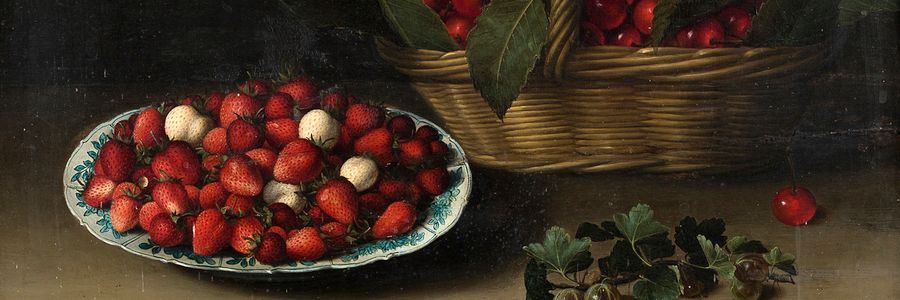THE RESTED NATURE OF LOUYSE MOILLON
Born in Paris in the early 17th century, Louyse Moillon was the daughter of Nicolas (1580-1620), a painter who was already well integrated into the circle of Parisian artists. Born in the Ardennes, he arrived in Paris at the end of the 1590s and moved in Saint-Germain-des-Prés, where he practised for some time before joining the Académie de Saint-Luc and moving to the Pont Notre-Dame. When he died in 1620, Louyse was only ten years old and although he was able to start teaching her the art of painting, it is her father-in-law François Garnier who took over from him. A still life painter, he was the most decisive influence in the construction of the artistic identity of the young artist. It was he who truly transmitted to her his proficiency of the brush and colours.
Although the body of work of this artist is limited, we cannot fail to compare her work with one of his compositions in the exact same disposition as the painting we are presenting today (Fig. 1). It is without doubt side by side that François Garnier and Louyse Moillon each observed and painted a still life with strawberries, cherries and gooseberries. The 21 year old student seems to have surpassed the master in the use of her palette and the relief she gives to her objects.

François GARNIER
Paris, 1634
(Fig 1) "Nature morte à la coupe de fraises, panier de cerises, branche de groseilles à maquereaux"
As a protestant painter, the artist was profoundly influenced by the tradition of Flemish and Dutch « stilleven » or "still life". This had spread particularly in Paris when an entire community of northern painters settled on the banks of the Seine, allowing local painters to copy and assimilate their techniques. As it is noticeable in the Nordic paintings, we can observe a great sobriety in the disposition, an extreme simplicity and a form of Jansenist rigour. Likewise, the colours, which are warmer rather than brighter, seem to be in line to what a Protestant dogma advocated under the aegis of Calvin, who had himself theorised their use as well as the spatiality of the compositions. Without ever yielding to superficiality, painters had to soberly represent the object as God had created it.
Following these codes and the ones she has applied her all career, Louyse Moillon structures her space with a simple wooden board slightly inclined towards us. She lays on it the strawberries on in a white and blue porcelain plate, a basket of cherries, one of which has escaped, and a bunch of gooseberries. Only the whole gets some light from the left, leaving the background and the environment in complete darkness. The sobriety of the whole is all the more present as it is arranged according to a strict triangular scheme.
The declinaison of the different elements also allows the artist to play with the materials. The fragility of the flesh of the fruit coexists with the roughness of the wicker, the brittle fineness of the porcelain and the simple rusticity of the entablature.
The pure chromatic palette, is composed of blacks, reds, browns and whites whose play of shadows subtlely enriches a limited range of colours. The dark background chosen gives the whole an aura of mystery, allowing the still life elements to spring for our eyes. This intensity of contrast seems representative of the first part of the artist's career.
It would be almost paradoxical (and a shame?) to speak of "nature morte" (in french, dead nature) for the works of Louyse Moillon. Before the middle of the 18th century, the term used to designate them was "rested nature", "silent nature" and was closer to its English translation, Still-Life, or Dutch, Stilleven. It is not death that the artist represents, or even the vanity or inexorable fleeting of time, but life. In this regard, the question has been raised to know whether or not Louyse Moillon's still lifes tells us messages, symbols. Iconographically, stylistically and technically in the tradition of her elders from the North, it could have been the case. However, according to her biographer Dominique Alsina, the artist's fruits should be seen only as a wish to present what she has observed. To share, beyond the places and years where she no longer is, what she took the time to contemplate. This is perhaps the poetry of the moment and the discretion of her art.

Louyse MOILLON
Paris, 1609/1610 - 1696
Coupe de fraises, panier de cerises et groseilles à maquereau
Oil on panel
Signed and dated lower right Louyse Moillon / 1631
36 x 50 cm
Estimate: €150 000 - 200 000
OLD MASTERS: PAINTINGS AND DRAWINGS
Auction
Friday, March 25, 3pm
Exhibition
Wenesday, March 23: 2pm - 6pm
Thursday, March 24: 11am - 8pm
Friday, March 25: 11am - 1pm
Hôtel des ventes Drouot - 9 Rue Drouot, 75009 Paris
AUCTION CATALOG
Grégoire Lacroix
Head of the Old Masters Paintings and Drawings Department
+33 1 47 45 08 19 • lacroix@aguttes.com



